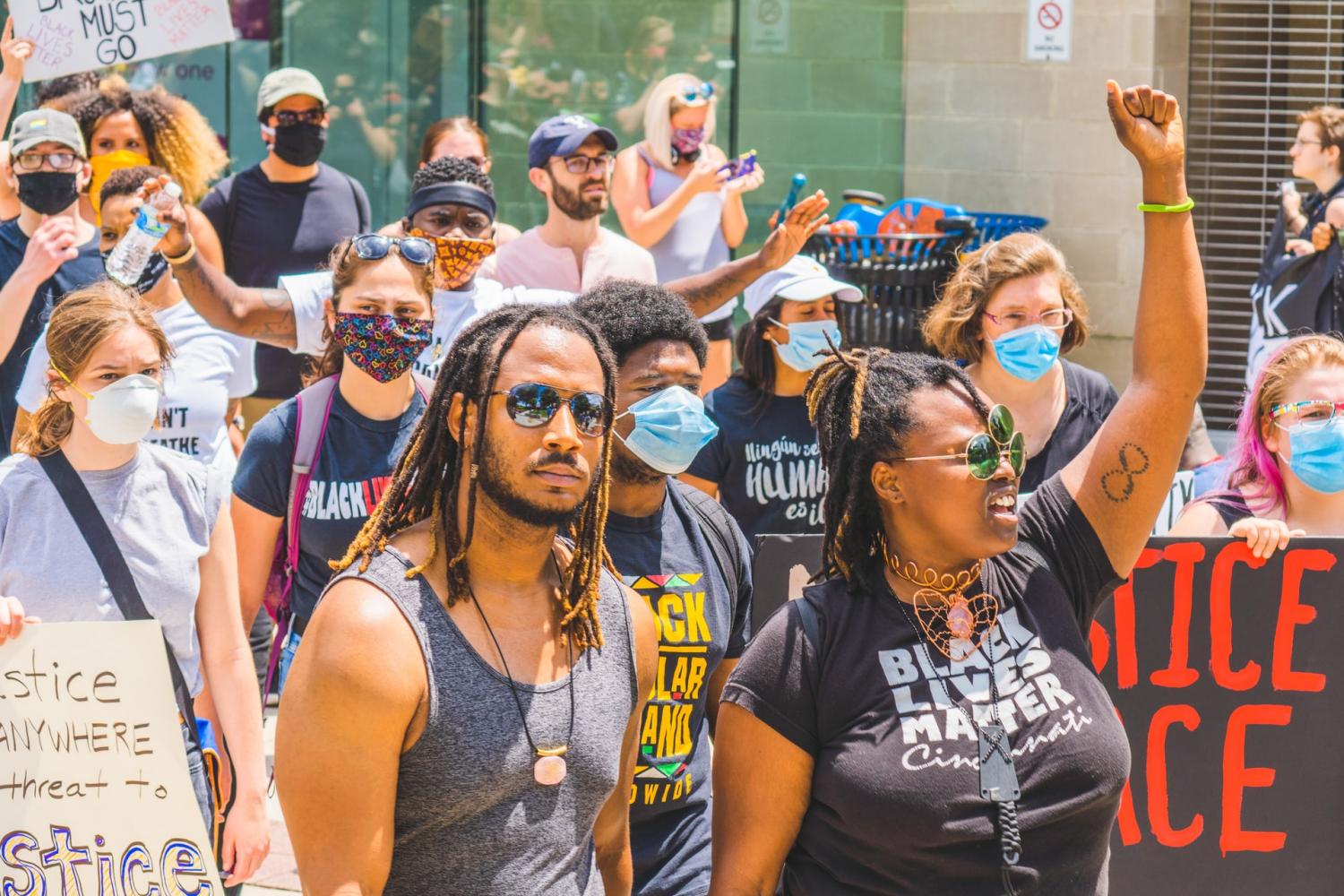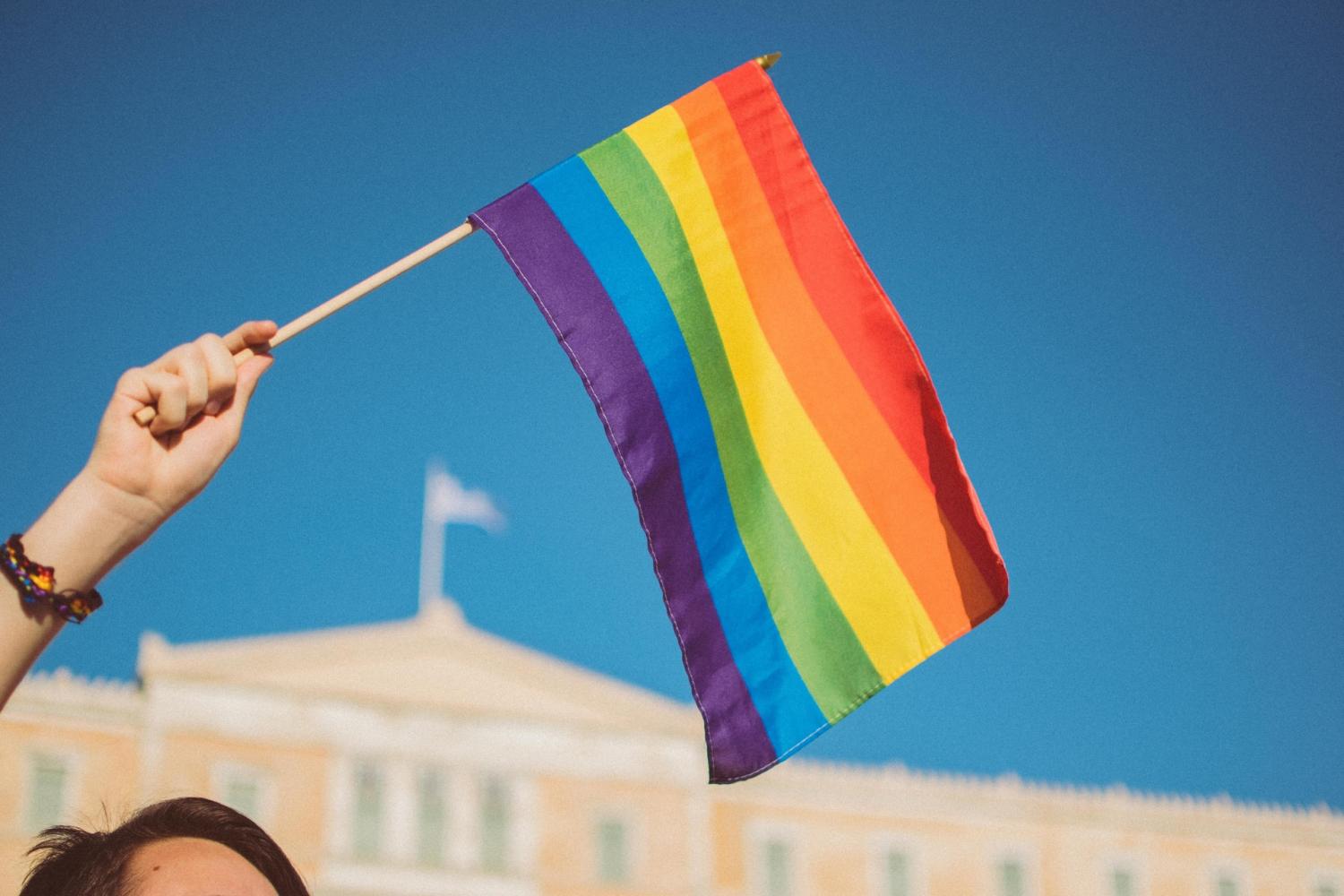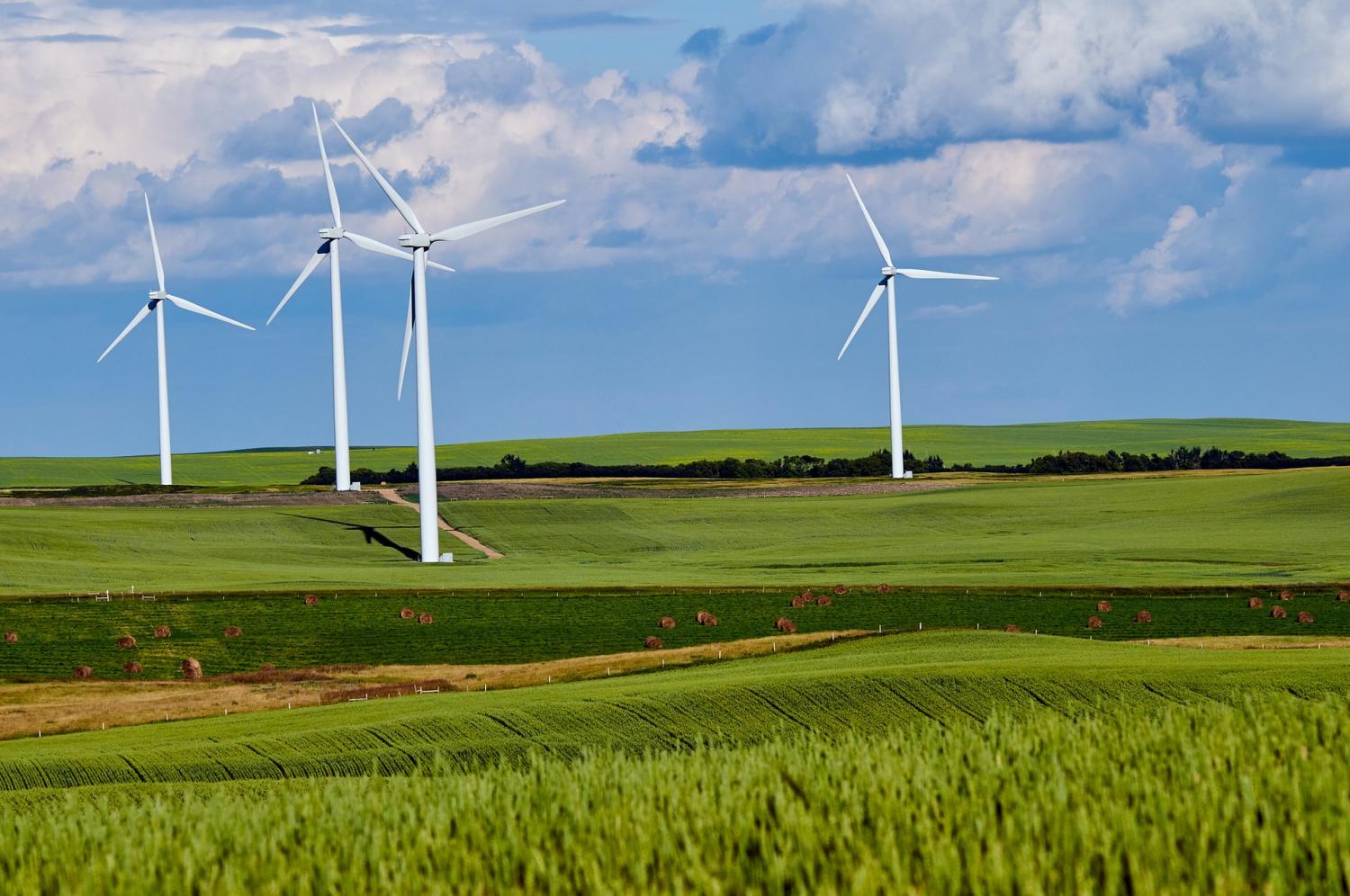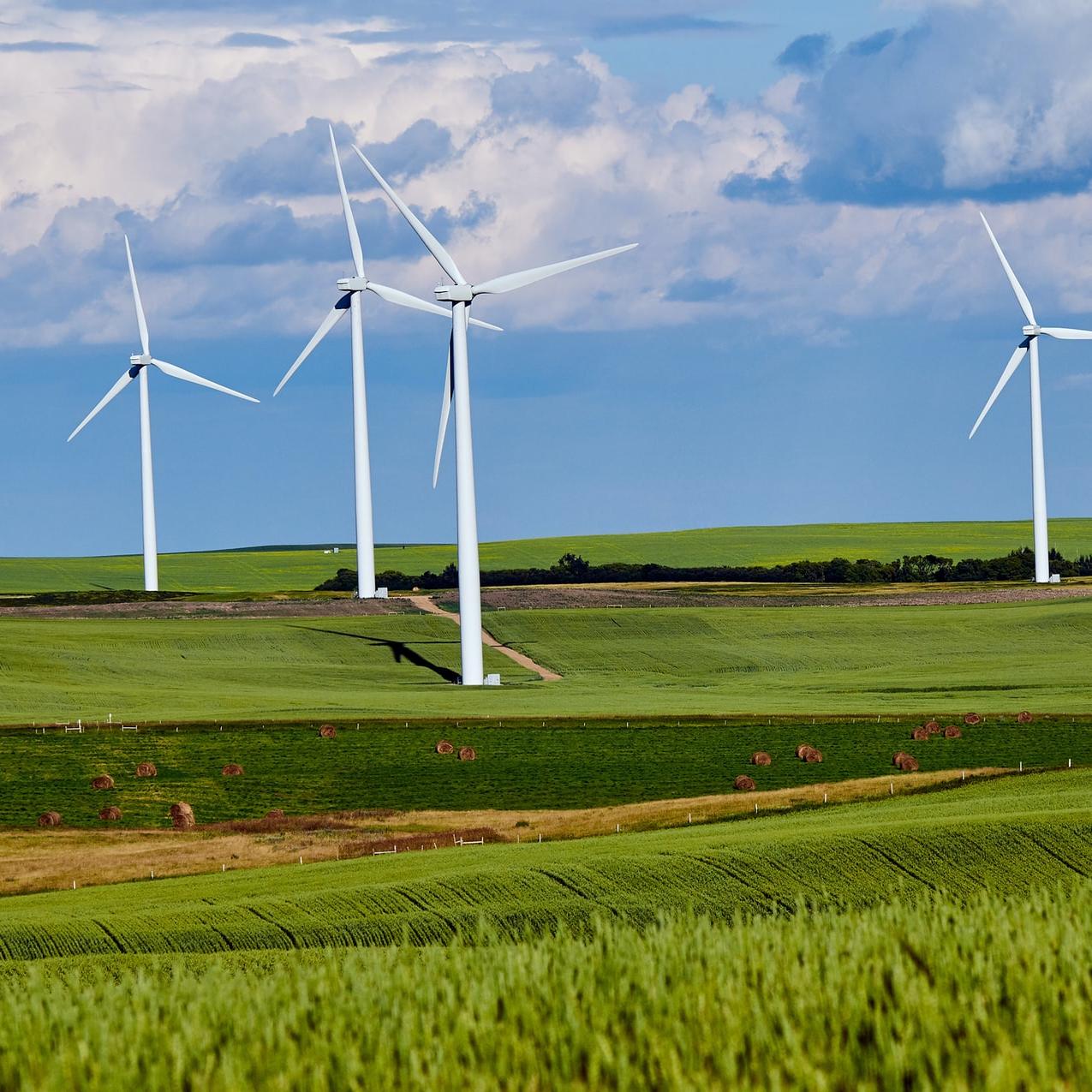How The Black Lives Matter Protests Complement Pride Month


Photo: A participant in Atlanta’s Pride Month during summer 2017.
Due to the COVID-19 crisis and social distancing guidelines, Pride Month 2020 had shaped up to be muted compared to previous years. Businesses supportive of the LGBTQ community may already be looking forward to a return to the traditional festivities next year. However, the sustained, nationwide eruption of Black Lives Matter protests over the death of George Floyd is already inspiring a deeper understanding of the very meaning of Pride Month.
The Black roots of Pride Month
To be clear, there are points of contrast. However, it is no accident that Pride Month organizers are looking through the prism of the Black Lives Matter movement this year.
The connection goes to the beginnings of the Black Lives Matter movement as personified by Kei Williams, a self-described Black transmasculine person, who is a Black Lives Matter founder and is an organizer with the Marsha P. Johnson Institute.
Soon after the first George Floyd protests occurred, mainstream media also took note of the connection.
On June 2, for example, reporter Jessica Sager noted that “the Pride Movement began with the Stonewall riots against police brutality and oppression in 1969, which were largely led by LGBTQ+ people of color (namely Stormé DeLarverie, Marsha P. Johnson and Sylvia Rivera), making Pride, at its core, a voice for intersectionality since its inception.”
LGBTQ organizations step up
Leading LGBTQ organizations have been quick to voice support for Black Lives Matter protestors. On May 29, for example, the Human Rights Campaign issued a statement signed by more than other 100 other groups. Another influential organization, GLADD, issued its own statement and took aim directly at intersectionality.
“There can be no Pride if it is not intersectional,” the GLAAD statement read in part.
Points of intersection
The statistics on police violence also support this perspective. A fact sheet produced by the National Coalition of Anti-Violence Programs includes these items:
“Transgender people were 3.7 times more likely to experience police violence compared to cisgender survivors and victims. Transgender people were 7 times more likely to experience physical violence when interacting with the police compared to cisgender survivors and victims.”
As a corollary, criminal justice analysts cite fear of police as a main factor in the under-reporting of violence involving LGBTQ victims.
In the context of COVID-19, another key point of intersection is public health. The virus has had a disproportionate impact on people of color, and on LGBTQ people as well.
“The coronavirus pandemic has put the LGBTQ community at increased risk for severe illness and death if they develop COVID-19,” health journalist Liz Seegert wrote in April.
“A lifetime of systemic discrimination and poorer health outcomes can make older LGBTQ people especially vulnerable, according to LGBT advocates,” she further explained.
The economic impact of the COVID-19 crisis is another point of comparison. A survey commissioned by Human Watch Rights Watch in April and May showed that LGBTQ people lost their jobs at a higher rate than the general population due to COVID-19, at 17 percent compared to 13 percent, with non-white LGBTQ people skewing even higher at 22 percent.
On May 9, USA Today also took note of race and geographic factors behind the disproportionate impact of COVID-19, reporting that “many more LGBTQ people are struggling with unemployment, homelessness and food insecurity compared with other Americans while simultaneously facing increased rates of health issues stemming from bias, mental illness and lack of insurance.”
New complications for Pride Month festivities
In drawing attention to the connection between Black Lives Matter and Pride Month, LGBTQ organizations — and their sponsors in the business community — may already be preparing for a different approach to Pride Month events next year.
Part of the difference may be financial. In some ways, the events of the past weeks may be forgotten by next year. However, groups that developed virtual Pride Month events have already seen a drop-off in sponsor interest attributed to the economic and social impacts of the COVID-19 crisis. Some sponsors may be reluctant to come back on board next year if there is a concern that Pride events may turn into protest events.
Another factor may be logistical, as some LGBTQ organizations are already reassessing their relationships with local police departments in light of the George Floyd protests.
The main difference, though, may be a renewed emphasis on protest and concrete action.
For all the progress on LGBTQ rights since Stonewall, the federal government during the Trump administration has turned back the clock.
Last year, the news organization Pro Publica listed 31 specific examples of federal actions having an impact on LGBTQ rights during the Trump administration, from military service to education, employment, health care, housing, criminal justice and more — despite the efforts of LGBTQ organizations to challenge these actions in court.
Many businesses have responded to the Black Lives Matter movement by donating generously to civil rights and social organizations. However, the experience of LGBTQ people, and that of other communities under the Trump administration, together demonstrate that cash can only go so far against a determined, organized enemy of civil and human rights.
As businesses plan ahead for their participation in Pride Month 2021, they should take a cue from municipal governments that are reassessing their financial support for militarized police forces that use violence against peaceful, unarmed protestors.
There are signs that movement is already beginning.
Earlier this week, for example, the U.S. bicycle company Fuji announced that it has suspended sales of its bicycles to police forces “in an effort to work towards real change.”
“In the last week, we have seen our bicycles used in violent tactics that we did not intend or design them to be used for,” Fuji said in a statement.
Similarly, earlier this week IBM announced that it halting its development of facial recognition software. In a letter supporting the Justice in Policing Act, the company’s CEO, Arvind Krishna, wrote that “now is the time to begin a national dialogue on whether and how facial recognition technology should be employed by domestic law enforcement agencies.”
Businesses seeking to make a real difference in advance of Pride Month 2021 could start now by shining a light on the role they have played in bringing the nation to this moment.
Image credit: JD Harvill/Wiki Commons
Microsoft Employees Urge for an End of Contracts with Police Departments


Image: A protest against police brutality following the murder of George Floyd, and in support of the Black Lives Matter movement, in Seattle’s Capitol Hill neighborhood. Employees at Microsoft are asking the company end its contracts with law enforcement agencies.
Conventional wisdom dictates that during times of high unemployment and economic chaos, employees should just keep their heads down, avoid ruffling any feathers and stay on task. Well, tell that to a group of employees at Microsoft.
According to OneZero reporter Dave Gershgorn, at least 250 Microsoft employees ended up copied on an email early in the morning on June 8. The note urged the company’s top executives, notably CEO Satya Nadella and executive vice president, Kurt DelBene, to sever any and all contracts with the Seattle Police Department (SPD) and other law enforcement agencies.
This wasn’t a rant from a few “woke” employees. In fact, the email summed up what these individuals experienced firsthand over the past two weeks. “Every one of us in the CC line are either firsthand witnesses or direct victims to the inhumane responses of SPD to peaceful protesting,” the employees wrote.
Gershgorn said the email at first only copied 20 employees, but as it ricocheted across the company, the number of employees who saw it increased more than ten-fold, which of course then led to it becoming published on OneZero and other technology news sites such as Engadget.
The email asked the company to follow through on several requests from employees, starting with the cancelation of any and all contracts with law enforcement agencies; public support for the Black Lives Matter movement in Seattle; a formal rebuke of the use of tear gas, flash bangs and rubber bullets; and a public call for the resignation of Seattle Mayor Jenny Durkan, who has come under fire for her perceived role in the city’s response to protests that occurred in the aftermath of George Floyd’s murder.
These demands have surely sent a chill up the spines of some of the company’s executives, board members and investors. Contracts with federal law enforcement agencies alone can ratchet up to the hundreds of billions of dollars. But for this group of Microsoft employees, this gravy train is one they believe they should pass on.
Microsoft has struggled with other leaked emails, including one from Seattle artist Shantell Martin. Posting a screenshot on Twitter over the weekend, Martin showed how an advertising firm representing Microsoft asked her to rush a mural the company had commissioned, with the logic that it needed to be completed by Sunday, June 7, “while the protests are still relevant and the boards are still up.”
Judging by the fact that protests over Floyd’s death are still ongoing, an eye on the news cycle is in the least bad optics — and a subsequent apology from Microsoft over the “insensitive language” comes across as effective as trying to shove toothpaste back into the tube.
Microsoft is among the many companies that have publicly supported the Black Lives Matter movement with words and funds. As anyone who plays dominoes knows, however, it only takes one poorly drawn tile to block progress. And on top of a group of upset employees who are now pushing for action, Microsoft risks a flurry of falling dominoes, as in poorly timed responses, which could dent its reputation.
Other tech companies have had to contend with employees upset at their employer’s technology being weaponized for what they see as immoral reasons. Last year, Palantir employees spoke out against the company’s technology contracts with U.S. Immigration and Customs Enforcement. Last week, some employees at Facebook walked out to protest the company’s hands-off approach toward the U.S. president’s violence-baiting posts.
Microsoft has done the easy part: Any company can write words and draft checks in a show of support. The hard part is actually following through and backing such support with action. No amount of word-smithing, however, will help Microsoft’s C-suite slip away cleanly from this dilemma.
Image credit: SounderBruce/Wiki Commons
How Companies Can Integrate Racial Equity into Their Business NOW!


The commitments to diversity, racial equity, inclusion and now their added companion, justice, flow liberally from corporations. In the wake of the recent horrific events surrounding the murder of George Floyd that unfolded recently, companies are racing even more quickly to publish their support for change. And they should. Corporations can have profound impacts on the most pressing issues facing our world from climate change, to food insecurity, to addressing the digital divide, and it is their responsibility to do so.
A blueprint for action on racial equity
I, like so many of you, have spent many hundreds of hours trying to convince my business partners about the value of diversity and the need for its integration across the business at every level. We would have seemingly endless discussions on the business case, correct terminology, mine our company for data (when the lack of diversity at every level was quite obvious) and roll out numerous initiatives which never seemed to make it past the initial few obligatory workshops. Then we would start up the next year, slightly different focus, yet little if no progress to be made.
As we all take a closer and more intentional look at how we are going to make progress in this fight for racial equity and justice, I would like to offer some thoughts on how a company should go about addressing racial equity in the near term, a blueprint of sorts.
It starts at the top
The CEO needs to be the “real” chief diversity officer. When a company has a serious goal, it lives at the CEO level. That is where annual revenue projections and other high-level business goals sit. There should be annual goals with clear, measurable objectives concerning diversity rolled out at the highest levels of the organization. The CEO should be able to articulate the goals and business case to internal and external stakeholders. All employees, across all levels of the company should be able to connect what they do in their day jobs to these goals and be expected to deliver against these goals.
Resource allocation
When a company supports an initiative, it follows up by investing money and people resources into such action. I would encourage companies to benchmark and create realistic budgets and headcount allocations to help get the important work of diversity done.
The four-pronged diversity strategy
There are four parts to a successful, integrated diversity strategy:
Diversity hiring, promotion and compensation-this is about the numbers. I encourage companies to set aspirational hiring goals to increase diversity (no these are not quotas and setting goals is legal). An example would look like this “we will increase our percentage of Black sales representatives by 5 percent, year over year.” To support this effort companies will need to evaluate their recruiting practices and how promotions, as well as raises and bonuses, are made to ferret out bias and more fully integrate equity.
Building an inclusive culture-if you want your diverse talent to stay at the company and to also have them engage fully you must do the work of creating a culture where everyone feels included and feels as if they can bring their best self to work. This should mean that everyone feels that they truly belong at the company and don’t need to “be” someone else when they show up. Committed efforts in management training, micro-aggression and bias training, and values and culture are required here.
Investing in diversity and equity in the value chain-this is about how the company advances diversity and equity within its value chain including suppliers, customers and the community at large. Building a diverse supply chain has a positive impact on the growth of diverse/underrepresented businesses community economically and could ensure a more competitive supply chain overall. Let’s also engage diversity and equity in our customer interactions to more fully show up as a true business partner and so we also are in tune with what our customers really want and need.
And finally, our broader community investments via philanthropy and sponsorship should not only reflect our corporate values and commitments to diversity but should also assure companies are addressing societal issues related to racial equity at the core. Companies should use philanthropic dollars strategically in addressing racism and social injustice.
Use your corporate voices to promote racial equity-use your corporate brand to take a stand. The biggest contribution a company can make on behalf of diversity and in the fight for racial equity and justice is to engage in the public dialogue. This could include sponsoring or signing onto a key piece of legislation or joining a coalition of companies to advance an initiative. Even just making a public statement to support racial equity is important (but be sure to include some real steps being taken by the company).
Finally, it’s imperative that companies not only set goals around diversity and put the above strategy into action, but also hold themselves more accountable for the progress they are (or are not) making. Implementing a comprehensive diversity program should not just be lip service. Solving for racial equity is hard work and requires a multi-faceted approach. This type of leadership demonstrates a company’s true commitment and authenticity to the efforts which will be required to truly achieve a more racially equitable and just society.
Image credit: Julian Wan/Unsplash
Today’s Crises Offer Even More Reasons to Support Pride Month


We’re almost a third of the way into Pride Month, but for the most part, companies have been silent. At face value, it’s easy to see why. We’re in the midst of a pandemic and economic free fall. Add the recent protests the murder of George Floyd triggered and, well, we all have enough on our hands, right?
Not so fast.
As this pandemic has shown, people living among us who are already most at risk are even more vulnerable to the ongoing public health and economic chaos. And that includes the LGBTQ community, especially gay and queer people of color, according to a recent Human Rights Campaign (HRC) and PSB Research study. More data has revealed the level of suffering occurring within these communities, “but little has been done in connecting sexual orientation, gender identity, and race regarding the pandemic’s impact,” said writer Matt Tracy.
To give a snapshot of what’s been unfolding during these crises, the HRC/PSB study concluded that almost 40 percent of LGBTQ people of color have had their work hours reduced, compared to 29 percent of white LGBTQ citizens and 24 percent of the U.S. general population overall. A similar disparity also shows on matters of asking for a delay in paying bills. Finally, when the study’s researchers asked respondents to assess their overall financial situation, black and brown LGBTQ citizens replied that they have felt the impacts of the past few months at a higher level.
A community harshly targeted
The effects COVID-19 has wreaked on LGBTQ people worldwide is summed up in a recent World Economic Forum op-ed:
“So many abuses on LGBTQI persons in this time of COVID-19 are going unnoticed. For example, the ways that some governments are now using contact tracing apps and internet-based technologies to monitor movements during lockdowns is posing a threat to the privacy and confidentiality of LGBTQI individuals – especially those living under repressive regimes who risk being targeted, outed and penalized for being queer.”
The gay community in Seoul, South Korea, is one example of how LGBTQ citizens feel unfairly targeted after reports surfaced that a man who had been stricken by the novel coronavirus had possibly exposed up to 5,000 people after visiting several bars and clubs in the city’s nightclub district. Uncertainty and fear have also become the norm within other LGBTQ communities worldwide.
“As racist stereotyping, finger-pointing and street attacks persist, reports across the world reveal a parallel phenomenon,” wrote Patrick Strudwick of Buzzfeed. “Institutions of power — from governments and churches to police and media — are blaming sexual or gender minorities for the spread of the virus.”
A virtual Pride Month still matters
As another Pride Month reminder, over 70 countries still criminalize LGBTQ citizens simply for living their lives as they are, and a dozen nations impose the death penalty as punishment for private, consensual sexual activity, according to information that organizations including Human Dignity Trust monitor.
The hostility LGBTQ citizens have confronted worldwide comes at a time when they are ready to celebrate their community, only to face the reality that a public health crisis led to cancellations of annual rallies, parades and marches. Pride Month also gives the opportunity to remember how horribly LGBTQ citizens have been treated, and at the same time, look forward in ensuring their rights are protected and strengthened. Hence the nixing of these events adds to the invisibility many of our LGBTQ neighbors currently face day after day.
The business community offers a voice, and the resources, to stand up for LGBTQ citizens, and Pride Month is the perfect time to take such action. This moment requires far more than a redesign of a company logo or the more unfortunate example of “pridewashing” we’ve shared in the past. LGBTQ-owned businesses could benefit from financial support or promotion; those who have had to move into a situation where they feel closeted and silenced at a minimum need to hear messages of hope; and governments should be warned there is no good time, ever, to take away equal rights.
Image credit: Stavrialena Gontzou/Unsplash
The Pandemic Affects the Pace of Renewables’ Deployment, Not Its Future


While the novel coronavirus pandemic stalled the expansion of the renewables sector in the U.S. and abroad, the industry is ready to ramp up as nations reopen.
“The largest effect from the pandemic we have seen [on the renewables’ industry] is the slowing of construction activity,” according to Erin Decker, director, cleantech client management for Schneider Electric. “It takes a long time for products to get built. There is slowing there, as well as slowing within the infrastructure and supply chain in the U.S. and Europe. There also is uncertainty in the capital markets, and some are slowing to look at new renewables in the U.S.”
Crises aside, renewables are poised for even more growth
Despite the economic slowdown of the past few months affecting construction, the U.S. Energy Information Administration (EIA) has forecasted that renewables will account for the largest portion of new electricity generating capacity this year. The EIA says it anticipates the power generation sector will more than 20 gigawatts of new wind power capacity and close to 13 gigawatts of utility-scale solar capacity in 2020 – in sum, the renewables sector will be the most rapidly growing source of power generation in 2020.
In a boost to the U.S. renewables industry, a recent IRS ruling allows solar and wind power companies with projects in the pipeline another year to get them online, due to the pandemic, and still receive the Federal Production Tax Credit. “Every business has had to adjust for safety, as the world emerges, and that goes for renewable energy as well,” added Decker.
Not to mention that goals for clean energy remain in place and banks and investors view renewable energy as a solid investment, according to Renewable Energy World.
Wind and solar power continue to be the dominant renewable energy in the U.S., and more companies are eager to finance projects through renewable energy certificates and power purchase agreements. “Some have invested directly,” Decker said. “There have been massive amounts invested by corporations already.”
Investment in infrastructure still crucial
Critical to the continued expansion of renewable energy sources in the U.S. is a renovated and smarter infrastructure. Some argue that infrastructure money should be included in subsequent federal stimulus packages, building on the success of the American Recovery and Reinvestment Act of 2009 (ARRA). Described by its advocates as the largest single energy bill in history, it contained $90 billion for the clean energy sector, which resulted in significant gains.
The desire to reduce carbon dioxide emissions coupled with falling technology costs is spurring many countries to pursue solar and wind projects.
Despite disruptions to the supply chain behind many projects, throwing off the commercial model for privately financed power plants, the Middle East and Africa are other regions eager to pursue renewable energy projects. “The region remains committed to diversifying its energy sources and lowering its costs through renewables,” according to GlobalData.
Globally, regulatory reform remains an obstacle for renewable energy. “Merging renewable energy, primarily photovoltaic solar power, into power grids requires policy adjustments and new regulations,” according to Richard Thompson, editorial director at GlobalData. “This includes ensuring grid flexibility and stability, integrating new technologies such as battery-storage and electric vehicles, and establishing commercially attractive business models.”
The low cost of renewables is the sector’s greatest selling point
As companies and governments map out their pandemic recovery, this is the ideal time to build “more green” into business plans, Decker noted. Similar moves already are underway in Europe, where there is rising demand for wind and solar power. European Union leaders have made it clear they want to see more sustainable development in long-term economic plans and may even tie stimulus funds to those proposals.
“Renewable energy is the cheapest source of power,” Decker said, adding that any new project helps to reduce carbon emissions. “If it has a financial advantage and an environmental advantage, and it could be built in to fight climate change, it should be built in.”
Companies also are conscious of consumer expectations for more sustainable practices on their part. “We’ve seen corporate demand for renewables explode; even during the pandemic companies wanted to expand,” Decker said. “As long as we are recovering, we should move forward as well—anything that makes economic sense. Besides, it is hard to imagine a post-pandemic world where consumers don’t hold companies accountable.”
Image credit: Abby Anaday/Unsplash
Want to Reduce Ocean Plastic Pollution? Reduce All Pollution


The ocean plastic pollution problem can seem intractable — after all, up to 13 million metric tons of plastic enters the ocean every year. And this pollution, unfortunately, does not simply float innocuously on the water’s surface. Marine life can ingest plastics, affecting ecosystem health and seafood.
Economically speaking, the costs can be surprisingly significant. Here’s one big number: $206,000. That’s the amount of damage marine litter causes the Scottish aquaculture industry each year. A 2018 study by Deloitte concluded that ocean plastic pollution results in a huge hit in countries that rely on oceans for their economic well-being: up to $19 billion across 87 coastal nations.
Over the past few years, the world has been grappling with how to solve the plastic pollution crisis. Cities have instituted plastic bag and straw bans. A Dutch nonprofit, The Ocean Cleanup, even began capturing waste from the Great Pacific Garbage Patch last year.
While these regulations, recapture schemes and curbs in consumerism are an essential part of protecting our oceans, they really only touch a small part of the problem. A Blue Paper commissioned by the High-Level Panel for a Sustainable Ocean Economy points out that visible plastic only makes up 3 percent of the total plastic in the ocean. If we are to truly cultivate a healthy and clean ocean system, the authors posit, we need a holistic approach.
Ocean plastic pollution is only part of the picture
It’s easy to be mesmerized by images of white sand beaches covered in colorful crops of netting and bottles and by the image of a mass of plastic twice the size of Texas gyrating in the middle of the Pacific, but we can’t afford to get distracted from the bigger picture of ocean pollution.
The Blue Paper, titled Leveraging Multi-Target Strategies to Address Plastic Pollution in the Context of an Already Stressed Ocean, emphasizes that truly effective action will diminish other types of pollution as well — including, but not limited to, fertilizer, heavy metals and oil.
The logic is quite simple. Pollution finds its way to the ocean via predictable pathways and means, no matter what it is. Going upstream and dealing with those common causes can have compounding effects, the authors contend.
Seven interventions for a clean ocean
Seven interventions — that’s what researchers found when investigating how to reduce pollution, including plastics, entering the ocean.
These strategies are simple (not easy) but very practical. Governments, people, nonprofits, and businesses can put these into practice in their local communities, cities, states and nations. Practical steps include managing wastewater, banning the use of harmful chemicals and improving coastal zones.
The interventions begin with the basic necessity of wastewater management infrastructure, which more than a third of the global population lacks. It goes without saying: Allowing untreated wastewater to enter the ocean threatens wildlife and human health.
The second suggestion confronts the literal streams of stormwater that carry any number of pollutants to the ocean, from residential litter to golf course fertilizers. The requirement here would be installing stormwater drain filtration and river mouth trash collection. These systems can stop not only litter from entering the ocean, but also chemicals and microplastics that come from sources including tire dust and even apparel.
A couple of interventions, of course, go to the absolute root of the problem: for one, using cleaner chemicals and materials and supporting research into less harmful materials, and reducing the use of plastics through fees, elevated industry standards and revised cultural norms.
Even though the report’s interventions are practical, they aren’t all obvious. The seventh recommendation is building local systems for safe food and water. Yet again, a third of the global population lacks access to clean drinking water. The authors note that adequate drinking water standards can reduce the need for single-use plastic bottles.
Ocean health requires cooperation
The oceans don’t see nations or borders, wealth or poverty — an important reminder as today is World Oceans Day. The oceans connect us. Likewise, they require cooperation to be truly healthy. To successfully implement these practical interventions, industries, sectors and political parties need to work together to solve the ocean plastic pollution problem.
What is encouraging about these interventions, though, is that they are feasible, and every community and jurisdiction can find a clear place to start and distinct steps to take.
Image credit: Artem Beliaikin/Unsplash
Big Business Has An Opportunity to Respond to Looting With Humanity


(Photo: People walk by businesses after looting in Minneapolis on May 28, 2020.)
"We can replace our windows and handbags, but we cannot bring back George Floyd, Ahmaud Arbery, Breonna Taylor, Eric Garner, Trayvon Martin, Emmett Till, and too many others. Each of these black lives matter.”
In a letter published on LinkedIn, Jide Zeitlin, chairman and CEO of Tapestry, Inc., expressed understanding, compassion and perspective in the face of looting that occurred during the Black Lives Matter protests.
Speaking out on inequality
As a CEO of a Fortune 500 company, maintaining solidarity in the face of destruction and theft speaks volumes. Zeitlin is one of four Black CEOs of a Fortune 500 company — a fact that itself speaks to the inequities experienced by Black Americans. In an interview with Good Morning America, Zeitlin — whose company owns Coach, Kate Spade and Stuart Weitzman — went so far as to say that the company’s losses can’t compare to those experienced by society, families and individuals due to systemic racism. He also noted that America will continue to face the same challenges until the underlying systemic issues are corrected.
In a sea of pithy #BlackLivesMatter posts on social media, Zeitlin’s remarks are a breath of fresh air, especially as they acknowledge the magnanimity large companies are capable of in this time of pain and hardship.
While words can only go so far, Zeitlin’s statement is powerful, as protestors continue to demand justice for George Floyd, Ahmaud Arbery, Breonna Taylor and countless others. These statements are especially meaningful against the backdrop of the rhetoric President Donald Trump has used toward looting.
On May 28, the president tweeted, “when the looting starts, the shooting starts,” a phrase also used by Miami Police Chief Walter Headley in 1967. Headley’s policing disproportionately affected Black communities, and he once said during a news conference that he didn’t mind being accused of police brutality.
Given the context, Zeitlin’s statement is a simple example of political corporate social responsibility filling the “regulatory gap” where government is not stepping up as it should.
Looting can lay a business bare, putting to test the values it claims
Other brands have also approached the riots with humanity. In his letter on May 29, Brian Cornell, chairman and CEO of Target, didn’t speak directly to looting, but he acknowledged the injustices and pain we are facing as a nation and noted the company’s emergency response for affected communities and employees.
“As a team we’ve vowed to face pain with purpose,” Cornell wrote. Target, which is based in Minneapolis, has temporarily closed or limited hours at 200 stores due to threats of looting. Its merchant and distribution teams are providing essentials like first aid equipment, bottled water and diapers to those in affected areas who may depend on the stores for what they need, he said.
Against the backdrop of these statements made by large companies, many of the small businesses that have been looted struggle to persist.
While looting may be a drop in the bucket for a Fortune 500 company, it can mean bankruptcy for mom-and-pop boutiques, especially after the coronavirus pandemic has shut them down for months. Small businesses don’t have the same luxury as retail chains to be generous in the face of property damage and theft.
To many citizens, looting has different meanings
Big businesses are in the unique position to give even more than what has been stolen and truly make a difference.
Those who are looting are illustrating the poverty people feel in a society that allows the top 1 percent of the population to hold more wealth than the entire middle class. Corporate compassion and giving are vital in this moment — but in the long run, transparency and accountability make ripples.
Amazon provides a useful example. The multinational conglomerate announced on June 3 that it would donate $10 million to organizations like the NAACP. Yet the company still places many of its workers in unsafe conditions and with inhumane productivity expectations, a problem exacerbated by the fact that Amazon’s leadership team doesn’t adequately reflect the diversity of its employee base.
If companies need an economic reason to become more honest and more socially responsible, of course value-driven companies gain a competitive advantage in this day and age.
To begin that journey, Zeitlin recommends business leaders do something that’s not exactly quantifiable: Be human — and there’s no better time. Zeitlin told Good Morning America that Tapestry, for one, will be having more of the honest conversations necessary for real change going forward.
Image credit: Lorie Shaull/Wiki Commons
Rewiring Fashion Shakes Up the Global Apparel Industry


While countless businesses were closed and the world was in lockdown, a group of independent fashion designers connected virtually to try to reshape their industry into something more interactive, creative, sustainable, and better in sync with both fashion seasons and consumers. Enter the forces behind Rewiring Fashion.
Created and fueled through the use of the messaging app WhatsApp, Rewiring Fashion could help shift consumer thinking away from the ideas that clothing is plentiful and disposable and reduce the waves of textiles flooding the market.
Fashion is beating up the environment, including the oceans
Critics of the industry have long been vocal about their belief that the fashion world needs a reset. A 2019 New York Times profile of the fast-fashion sector suggested that up to 85 percent of textile waste in the U.S. goes to landfills or is incinerated. Add the fact that about 60 percent of fabrics are synthetics, and a little math would show how much fossil fuels are wasted in the process. Francois Souchet of the Ellen MacArthur foundation also made the point last year that, overall, the amount of time garments are worn before they are disposed has decreased 40 percent over a 15-year period.
And with today being World Oceans Day, it’s worth a reminder that fashion’s impact is everywhere. That includes the oceans: The U.N. Environment Program estimates that 1.4 million trillion plastic fibers have ended up in the ocean. Put another way, doing laundry alone results in the flow of half a million metric tons of plastic fibers into oceans each year, equal to 3 billion polyester shirts.
Rewiring Fashion wants to reset how we make and buy garments
Rewiring Fashion’s most compelling recommendation involves revamping the fashion calendar so there is less time between when fashions make their debut on runways and then arrive in stores. The end result, these designers believe, would include the extension of the full-price shopping period, while matching clothes on the racks with the actual season, which would eliminate the disconnect of a shopper seeking a winter coat in January and finding bathing suits.
Such a shift would also avoid copycat designers producing less expensive versions of certain pieces after seeing them in fashion shows and getting them into stores first, which often cuts into sales while leading to surplus inventory.
Four proposals Rewiring Fashion is asking of the industry
Rewiring Fashion seeks goals beyond tamping down copycat designs. The group’s goals include:
Consolidation: Rewiring Fashion seeks to cut down on the number of men’s and women’s fashion weeks in January, February and June. The outcome would be cutting back on the flights dozens of people would need take while they attend multiple fashion shows in various cities, often as many as eight per designer, per season. A compressed calendar would also save money and resources. A fashion show lasting between 10 and 15 minutes can cost $200,000 to more than $1 million.
More direct contact: Abandoning the current format for fashion shows was also proposed, replaced by more interaction with consumers and digital fashion presentations designed to engage customers right before new items land in stores so designers can decide how to show off their products.
Cutting back on discounts. The organizers behind Rewiring Fashion argue that the holding of sales too early and too often motivates shoppers to delay buying, which reduces the number of full-price sales and, in the end, affects the profits of retailers and designers.
Rethinking big sales. Should retailers postpone their largest sales until January or July — and even eliminate Black Friday and Cyber Monday sales? Many retailers would reply that the fashion industry will have little choice but to deeply mark down this year’s spring and summer wear because of the coronavirus pandemic, but a rethink of those big quarterly sales begs for a reset, Rewiring Fashion says.
The future of sustainable fashion
The fashion industry has long been in need of a makeover, as it is one of the most environmentally taxing when it comes to using resources, generating pollution and waste. The sector is also among the largest consumers of water and produces 10 percent of all carbon emissions — more than the combination of all international flights and maritime shipping. If the fashion sector continues as if it’s business as usual, its share of the carbon budget could be as high as 26 percent by 2050, notes a 2017 report from the Ellen MacArthur Foundation. Greenpeace reached a similar conclusion in September 2019.
Nevertheless, numerous sustainability measures and groups are already working and evolving, the newest of which includes the United Nations Alliance for Sustainable Fashion, which is working across various stakeholder groups to help push the industry to become more environmentally-friendly.
Rewiring Fashion is gaining supporters, and is being backed by the Business of Fashion and co-signed by brands such as Proenza Schouler, Missoni and Rodarte.
“This is a proposal for the global fashion industry, the product of ongoing conversations between a growing group of independent designers, CEOs and retail executives from around the world who have come together in this challenging time to rethink how the fashion industry could — and should — work,” reads Rewiring Fashion’s statement.
“This statement captures our collective thinking about the actions we must take to preserve the beauty, creativity, and craft of our industry, while building solid, sustainable businesses that can survive the current storm — and beyond,” concludes the group.
Image credit: Flaunter/Unsplash
Taking on Racism? Don’t Overlook Climate Justice


(Photo: a young visitor poses at Joshua Tree National Park, located in southern California’s Mojave Desert)
People are angry and scared right now, from the pandemic to police brutality to climate change. Every day brings another story of prejudice or abuse, of people dying and small businesses failing. Justice is the word on everybody’s lips. But what does that mean? And how can those of us in the environmental space participate in the conversation? The simple answer is that the social change millions of people are seeking right now is inextricably linked with climate justice.
As Dr. Adrienne Hollis, senior climate justice and health scientist at the Union of Concerned Scientists, told me, COVID-19 — on top of climate change, on top of poor air and water quality — means vulnerable communities are living through a syndemic, a situation in which multiple, interrelated epidemics are happening at the same time and exacerbating each other.
The background of why climate justice has been denied to people of color
African Americans are significantly more concerned about climate change than whites (57 percent to 49 percent), and with good reason. Communities of color are disproportionately affected by poor air and water quality and other impacts of climate change. This situation makes the people living in these communities more vulnerable to complications and death from COVID-19, witnessed by the numbers: Nearly twice as many deaths than would be expected based on the percentage of the national population.
It is an often repeated misconception that African Americans do not care about the outdoors or want to be in wild places. There are two things at play here: One, African Americans, especially in the South, have a long, deep connection to land. The ability to own land after the abolition of slavery was a point of freedom. Formerly enslaved people who owned land did marginally better overall economically, but institutional racism kept firm limits on their ability to prosper.
Second, the problem is not one of dislike or unwillingness to partake in the outdoors, but access. National parks in the U.S. were designed to be white, to help escape the urban — read: minority — situation, and African Americans still only make up around 1 percent of their visitors annually. The reasons they often cite for not visiting these parks include affordability and access, historical trauma, fear for personal safety, and discrimination. City pools and public beaches were segregated in most places, leaving a legacy of separateness — as in, separate but never equal.
There still remains a separateness in the open spaces of the outdoors. After a white woman called the police on avid birdwatcher Christian Cooper in New York's Central Park, the Twitter account @BlackAFinSTEM launched #BlackBirdersWeek to highlight African American birders and scientists. Here is where the end of the circle meets its beginning: In order to solve climate justice problems, we need the scientists and engineers who both understand the technical issues and the communities they affect. Yet African Americans make up only 9 percent of science and engineering jobs in the U.S. And those in their ranks often report prejudice and bias up and down their careers, no matter how accomplished they are.
As Dr. Hollis points out, kids need exposure to leaders in the fields of science and law who look like them, and they also need access to education and funding to back it up.
Solving climate justice requires multi-layered solutions
In a discussion between Dr. Hollis and Dr. Sacoby Wilson from the University of Maryland, Dr. Wilson pointed out that “the COVID pandemic has made what was invisible visible.”
“Now we see that we need to protect frontline healthcare workers and vulnerable communities," Dr. Hollis added. "Systemic racism has put people at risk, and we have reached a teachable moment, a moment where we must address the issue head on. If we address the heart of the justice issue, we address climate injustice and all the rest. You cannot separate them.”
She notes that solutions must begin at the community level. “Look through a small lens to start and then widen the scope,” she said. The message is not the only important thing, but also the messenger. There is trust built in if you look to the community, she noted. Businesses and community leaders must work together to find the solutions for what works best because there is no one-size fits all solution, though businesses, government, community leaders, and academia can learn from each other. What works in Houston may not work in St. Louis, but they can share and work to rebuild the institutions to better serve everybody.
As Mustafa Ali of the National Wildlife Federation, who previously worked within the U.S. Environmental Protection Agency under President Barack Obama, has said, communities need to be empowered to “move beyond surviving to thriving.”
“We’re all in this together” doesn’t mean everybody is in the same boat or has the same experiences. It means we are human beings on the only planet we have, and we all have a stake in protecting the vulnerable, lifting up the marginalized, and being accountable and responsible to our fellow human beings. As Cornel West, American philosopher and author, has said, “Justice is what love looks like in public.” Justice for the people suffering most in this syndemic will require everyone to solve it, most especially those who have not yet been given a chance.
Image credit: Samantha Sophia/Unsplash
Carbon Recycling Offers Hope for More Sustainable Air Travel


The airline industry has woken up to a new reality under the COVID-19 pandemic, with fears of viral infection during travel layering over concerns about the role of jet fuel in the climate crisis. Nevertheless, there are signs that the aviation sector is beginning to recover, and so are the prospects for sustainable air travel.
Speeding up the jet biofuel process for more sustainable air travel
The airline industry has been working its way toward a biofuel solution, but progress has been slow, and scale is still a problem. In addition to technology barriers, the fuel certification and safety process can spin out over years.
A tipping point does appear at hand, however. This year, ASTM International, the agency that certifies jet fuel, introduced a “fast track” process for biofuel producers with guidance from the Federal Aviation Administration. The first such formula to achieve certification under the new process involves the gasification of municipal solid waste, forest waste and other biomass in a blend with fossil fuel.
Investment by oil and gas stakeholders is also playing a role. One interesting example is Chevron. Some energy industry observers suggest the company has fallen behind other fossil fuel companies in the wind and solar power generation fields, but its Chevron Lummus Global venture has partnered with the firm Applied Research Associates to develop a 50-50 blend of petroleum and waste grease for jet fuel.
The formula won ATSM approval in February and plans are in the works to produce it at scale for markets in the U.S. and Japan.
Recycling carbon from unconventional sources
Both of these projects involve unconventional sources for biomass. That represents a significant step up from the current practice, which depends heavily on cultivating biofuel crops on agricultural land.
Biomass is a form of carbon recycling, so another step up would be to deploy sources that convert carbon more efficiently than crops or forest waste.
That explains the interest in algae, which can convert carbon much more efficiently than other plants under the right growing conditions.
ExxonMobil has been active in the area of algae biofuel in partnership with the firm Synthetic Genomics. The field has also enjoyed support from the U.S. Department of Energy.
Commercial prospects seem distant. However, the growing urgency of climate action may restart interest in market-worthy algae-based fuels, as algae farming can provide a means of capturing and recycling carbon directly from power plants and other industrial operations.
Scaling up new technology
In contrast to Exxon’s foot-dragging, the tar sands oil company Suncor provides an example of the sharp pivot that some fossil companies are making into commercial biofuel with a high-tech carbon recycling twist.
Suncor has joined with the Japanese financial firm Mitsui in a combined $25 million biofuel venture called LanzaJet, which is an offshoot of the biotech firm LanzaTech. All Nippon Airways is also participating in the venture.
LanzaTech has developed a “robust” microbe-based carbon recycling process that deploys living organisms to digest waste gas, with substantial assistance from the U.S. Department of Energy.
Under the new partnership, LanzaJet will build a 10 million gallon-per-year demonstration plant in Georgia, with an additional $14 million in assistance from the Energy Department. The plant is expected to begin operations in 2022.
Suncor and Mitsui have also developed a novel “phased investment” plan aimed at spurring interest among other investors in additional facilities, on an accelerated timeline.
Years of work lie ahead as the airline industry unpacks its dependence on fossil fuels. However, the industry is moving forward even in the depths of the COVID-19 pandemic.
The accelerated jet biofuel certification process, the use of more sustainable feedstocks, the carbon recycling angle and the scale-up of investor interest in new technology all point the way to more sustainable air travel as the global health crisis eases.
Image credit: Dominik Scythe/Unsplash